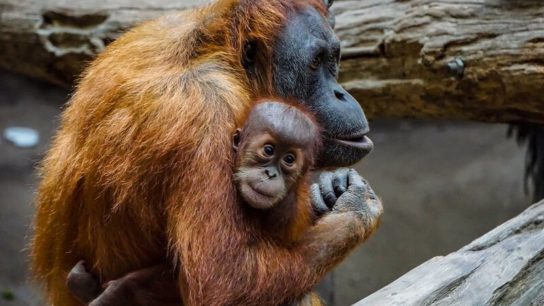The sex of sea turtles is temperature-dependent with more females born in hot temperatures and males at lower temperatures. Increasing global temperature has important implications for sea turtle management and survival. Read on to find out why sea turtles are endangered and what the future holds for this beautiful animal.
—
How Temperature Influences Sea Turtles’ Sex
Sea turtles and most crocodilian species differ from other reptiles and vertebrates by the nature of their temperature-dependent sex determination. This means that the sex of sea turtles is not dependent on sex chromosomes. Instead, it is determined by the temperature at which the eggs develop.
Research has shown that eggs incubated below a temperature of approximately 82 degrees Fahrenheit (27.8C) produce males while eggs incubated at temperatures of roughly 89 degrees Fahrenheit (31.7C) produce females. In instances where nest temperature fluctuates between these upper and lower limits, a mix of males and females is produced. The warmer the upper limit, the greater the female-to-male ratio while the lower limit skews the ratio toward males.
You might also like: 7 Interesting Facts About Sea Turtles
Unlike sea turtles and some crocodilians, vertebrates – including humans – possess sex chromosomes. Sex chromosomes are passed from parents to their offspring at the time an egg is fertilised. In the simplest terms, there are two types of sex chromosomes: X and Y. In the gametes, male (sperm) and female (egg) germ cells, X chromosomes are unique to females. Before fertilisation, an egg has a single X chromosome. Sperm, however, contain either an X or Y chromosome. At the time the sperm fertilises the egg, the sex of the offspring is determined. An egg fertilised by a sperm with an X chromosome produces a female with two XX chromosomes. An egg fertilised by a sperm with a Y chromosome produces a male (XY)*. The chance of producing offspring that is female or male is typically 50/50.

Image by Pamela Ferris-Olson.
Why Sea Turtles Are Endangered: The Case of Florida
Florida’s beaches are an excellent place to study temperature-dependent sex determination. That’s because the state has more loggerhead turtles (also referred to as ‘caretta caretta’) nesting on its beaches than anywhere else in the world. It has been observed in recent years that the majority of turtle hatchlings in Florida have been female.
You might also like: Shortage of Male Sea Turtles in Florida as Temperatures Reach Record High
Research has determined that the skewed ratio of female-to-male loggerheads is due to a pattern of higher temperatures, above 89 degrees Fahrenheit, recorded during the sea turtle’s May to October nesting season. This phenomenon, however, is not limited to loggerheads. A 2018 study of green sea turtles in Australia’s Great Barrier reef also noted an increase in the percentage of female hatchlings.
Sea turtles are long-lived and mature slowly. These facts make it difficult to identify their sex because they do not appear sexually dimorphic – showing male and female traits – until they are around 25 years old, the age they typically become sexually mature. With global temperatures rising at an unprecedented rate, it is ever more important for the management of sea turtle populations to monitor the sex of turtle hatchlings.
Researchers at Charles E. Schmidt College of Science at Florida Atlantic University (FAU) announced they have “developed a first-of-its-kind technique that is minimally invasive and greatly enhances the ability to measure neonate turtle sex ratios at population levels across nesting sites worldwide.” The technique requires blood to be taken from a hatchling. The samples are evaluated via western blot analysis. This technique “is quick, minimally invasive [requiring a very small volume of blood], and the hatchling turtle can then be released immediately.” – researchers explain.
The FAU study found the presence of the anti-müllerian hormone (AMH). AMH plays a key role in the development of a sea turtle sex organs. Male hatchlings had the hormone while females did not. The presence of the hormone is a reliable tool for sex determination with a high level of accuracy for identifying a hatchling’s sex. These research findings have important implications that can help “estimate how climate change will affect future generations of hatchlings, and allow for expedited evaluation of management strategies used to help recover imperilled sea turtles and other reptile species with temperature-dependent sex determination.”
What Does the Future of Sea Turtles Look Like?
If ambient temperatures continue to increase there will come a point where the ratio of male to female is no longer problematic issue because the nest temperature will be too hot . The result will be 100% mortality. To avoid this possibility, researchers are considering interventions. At least one researcher remains positive about sea turtles’ long-term survival. Jake Lasala, a researcher with the Mote Marine Sea Turtle Conservation & Research Program in Sarasota, Florida, believes that sea turtles have a strong survival instinct. As an example he noted that, “this past summer, a female loggerhead laid eggs far north of Florida on the cooler sands of the Jersey Shore.”
*This description does not take into account genetic variations that occur on occasion, as for example, Klinefelter syndrome (XXY) where a boy is born with an extra X chromosome.
You might also like: 6 Sea Turtle Species Endangered By Climate Change and Human Activity














